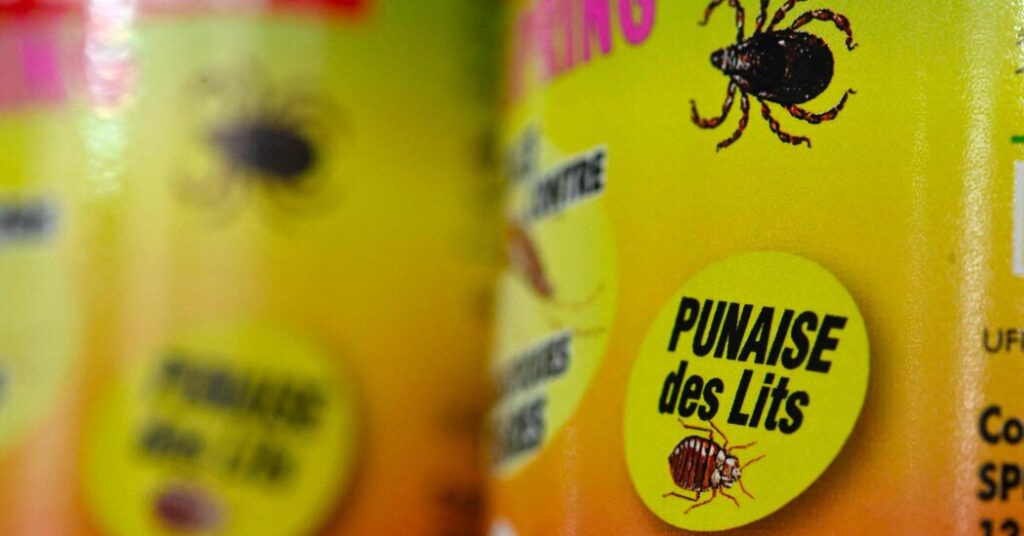[ad_1]
The talk of Paris Fashion Week this year has been the little, brown bug — bedbugs. The pests have popped up in trains, airports and movie theaters, fanning fears that they may also be lurking in hotels, an echo of New York City’s mid-2000s bedbug panic. The cities and decades may be different, but the scourge is eternal.
Bedbugs don’t just live in beds. These apple-seed-size insects can hide out in furniture, waiting for their chance to come out, usually at night, to feed on humans’ (and pets’) blood while they sleep. Their bites, usually painless, often occur in clusters or lines.
Although bedbugs generally pose minimal risks to health, said Bryon Backenson, director of communicable diseases at the New York State Department of Health, their bites can cause allergic reactions for some and, of course, they are a source of discomfort and anxiety for pretty much everyone else.
Even if you’re not headed to Paris, there are some ways you can prevent bloodsucking stowaways from sneaking home with you, wherever you travel.
When you arrive
Check your hotel room before you settle in, even if the room is spotless. The warmth, blood and carbon dioxide of humans are far more important to bedbugs than an unsanitary environment, according to the Environmental Protection Agency’s bedbug myth website. But, the website adds, clutter can help them hide.
When you first enter the room, immediately put your luggage in the bathroom, then do your bedbug inspection, advises Jody Gangloff-Kaufmann, a senior extension associate at Cornell University who focuses on pest management and has a doctorate in entomology.
Adult bedbugs are wingless and have six legs and a flat, oval body. They’re about the size of Lincoln’s head on a penny, according to the Centers for Disease Control and Prevention. The eggs are pearl white and about the size of a pinhead, the E.P.A. website says.
Thoroughly check the bedding, box spring, bed skirt, side tables and even the alarm clock, anywhere the bugs can hide.
“The first thing you might notice is the fecal stains that they leave behind, which is kind of like magic marker dots in fabric,” Dr. Gangloff-Kaufmann said.
Also check the headboard; some can be popped off the wall. If there is powder behind the headboard, Dr. Gangloff-Kaufmann said, that may a sign that the room has been treated for bedbugs in the past.
Pack a small LED flashlight you can use as you do your inspection. It will help illuminate any eggs or shells discarded during molting. Finally, check the rest of the furniture and any nooks or crevices — think baseboards, moldings and floors — around the room. A sweet, musty smell may also indicate the presence of bedbugs.
Commercial bedbug tests such as the swab-based TruDetx, which promises “reliable detection in just five minutes” may work, but do not have enough scientific studies backing them up, said Dr. Gangloff-Kaufmann. They can also provide a false sense of security, Mr. Backenson said.
If you find any evidence of bedbugs, do not stay in the room. Instead, contact the hotel staff, leave the room with your belongings and request a room in another part of the hotel — not adjacent to the infested one.
During your stay
Minimize the places a bedbug could hide by storing your clothes in sealable plastic bags. Some travelers also bring large, airtight plastic bags for their luggage.
A hard suitcase, Mr. Backenson said, may be a safer choice than soft luggage because it has fewer crevices where bedbugs can stow away. Always keep your luggage on a rack, away from the wall, or in the bathtub.
Do not sprinkle diatomaceous earth — a white, silica-rich powder that some travelers have deployed to desiccate bedbugs — in a hotel room, Dr. Gangloff-Kaufmann said, because it may contaminate the room and potentially even cause a scare if a hotel worker sees it and doesn’t recognize it.
Blasting your luggage or clothes with a hair dryer or a portable steamer, another popular tip, may not work because the temperature may not be high enough for long enough to kill the insects, said James Mulloso, vice president of Northeastern Exterminating in Brooklyn. Their eggs may take up to 90 minutes at 120 degrees Fahrenheit to destroy, the E.P.A. says on a web page for bedbug control.
Wiping down your suitcase with rubbing alcohol, another popular bedbug-fighting strategy, can help kill the insects if done safely in a well-ventilated area, Mr. Mulloso said, but keep in mind that rubbing alcohol is flammable, and it could be dangerous.
After you return home
After your trip, unpack your bags in the bathroom against a light-colored surface, so you can spot any bugs, the New York City Department of Health advises, then shake out the clothing in a bathtub or shower and vacuum out your luggage. Don’t forget to empty the vacuum and dispose of its contents.
Put your clothes in the dryer as soon as possible, the experts agreed, and run it at the hottest setting for at least 20 minutes to kill bugs and eggs.
If you think an item has been exposed to bedbugs and it cannot go in the dryer, seal it in an airtight plastic bag and leave it in a warm area for six months — the time it takes for the bugs to die from lack of water, Dr. Gangloff-Kaufmann said.
Follow New York Times Travel on Instagram and sign up for our weekly Travel Dispatch newsletter to get expert tips on traveling smarter and inspiration for your next vacation. Dreaming up a future getaway or just armchair traveling? Check out our 52 Places to Go in 2023.
[ad_2]
Source link


